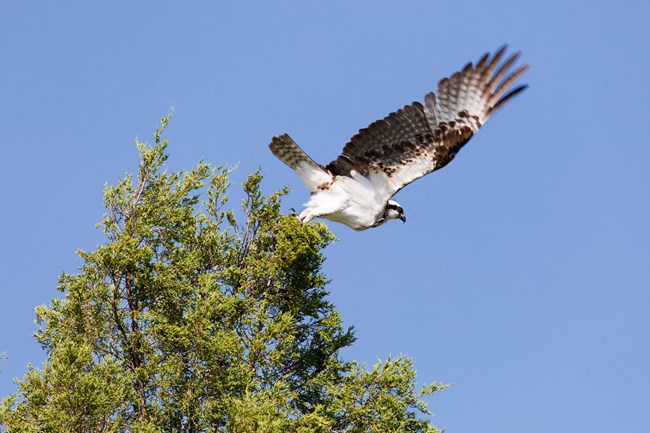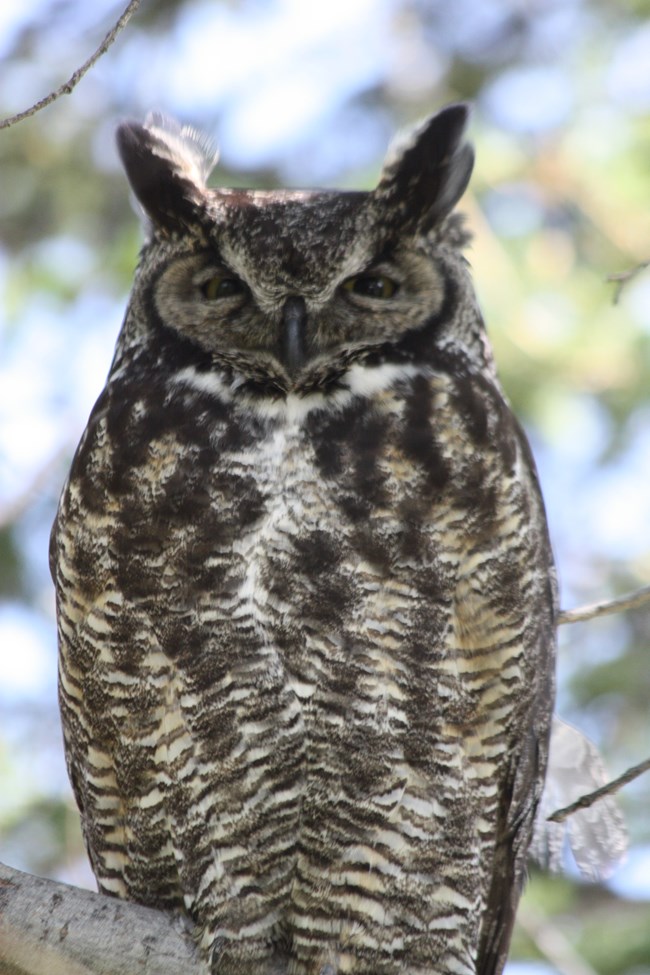Last updated: August 20, 2021
Article
Saugus Birds of Prey

NPS Photo / Neal Herbert
What birds of prey are regularly seen in and around Saugus Iron Works NHS?
Turkey Vulture (Cathartes aura). These are large birds that are usually seen circling high above the park. They eat primarily carrion and migrate to the southern United States in the winter.Osprey or Fish Eagle (Pandion haliaetus). These are large birds that eat fish. They will hover on beating wings and then plunge feet first into the water to catch their prey. There are several nesting pairs on platforms atop telephone poles outside the park boundaries. They are frequent visitors to the park fishing in the turning basin.
They migrate for the winter to Florida, the Gulf coast, Central and South America. Osprey usually return to the same nesting (summer) and wintering sites each year. Changes to nesting areas, along migration routes and in wintering areas threaten populations of osprey and other neotropical migrants.
Bald Eagle (Haliaeetus leucocephalus). These are very large birds that feed primarily on fish, living or dead. A pair have been seen up and down the Saugus River and over the reservoirs in Lynn recently. They winter in Florida and along the Gulf coast.
Red-tailed Hawk (Buteo jamaicensis). A large, soaring bird usually seen circling high above the turning basin, occasionally swooping down to prey on the mice and chipmunks living in the stone walls. They also eat rabbits, occasionally small birds, reptiles, and grasshoppers. They are year-round residents in this area.
Red-shouldered Hawk (Buteo lineatus). Another large, soaring birds similar in size to the Red-tailed Hawk, with a similar diet. Winters over in southern New England, the Mid-Atlantic states, or further south and west.
Common Screech Owl (Otus asio). This is a small eastern owl. It hunts primarily at night for rodents, birds, reptiles, fish, and large insects. They are year-round residents.

NPS Photo / Robbie Hannawacker
What other birds of prey are common in this area?
Great Horned Owl (Bubo virginianus). This large owl is similar in size to a Red-tailed Hawk and has bulky, broad ear tufts. They are nocturnal and perch until they can see or hear their prey with their superb eye-sight and hearing. They eat mostly small mammals up to the size of rabbits and skunks. They are year-round residents.
Barred owl (Strix varia). A medium-sized owl that prefers hardwood forests with open understories. The barred owl hunts small mammals at night and lives here year round.
Sharp-shinned hawk (Accipter striatus). This small hawk has a slender body, short rounded wings, and a long tail. It feeds on small birds which it captures in flight. In suburban areas it will perch inconspicuously near bird feeders. It migrates from the northern parts of its range to southern New England, the mid-west, and south-east in the fall and back again in the spring.
Cooper’s hawk (Accipter cooperii). Cooper’s Hawk looks like a larger version of the Sharp-shinned Hawk. They have similar habits and range. Though Cooper’s Hawks will prey on smaller birds and occasionally small mammals, they prefer medium-size birds like doves, pigeons, starlings, jays, and even pheasants and chickens.
Broad-winged Hawk (Buteo platyterus). This small hawk spends most of its time in forests under the canopy where it perches looking for prey. They swoop down to snatch small mammals, amphibians, and insects off the ground. In the fall they migrate to South America in huge flocks that can number thousands of individuals. Known as “kettles,” these flocks can be seen in giant circling masses as they ride rising thermals to gain altitude for the next leg of their journey. These hawks are only likely to be seen in the park during spring and fall migrations.
What other birds of prey are possible rare sightings around the park?
Barn Owl (Tyto alba)
American Kestrel (Falco sparverius)
Merlin (Falco columbarius)
Northern Harrier (Circus cyaneus)
Peregrine Falcon (Falco peregrinus)
